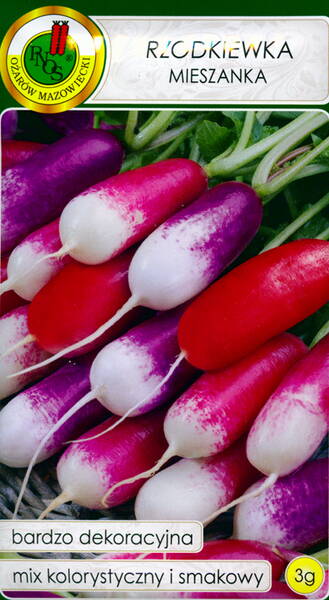Your shopping cart is empty!
Radish "Trio mix" (collection of long varieties)
Mix of popular long-fruited radish varieties: Slovana + Forum + Felicia.
* Radishes are one of the most popular early-ripening vegetables. During the season, three root crops can be harvested from the same ridges. Loose, moist, fertile soils of a neutral or slightly acidic reaction are allotted for radishes. On structureless and nutrient-poor soils, the vegetable does not form a root crop.
Usually, radishes are sown in the ground from April 15 to May 15 and from August 15 to September 1. This is due to the fact that heat and long daylight hours cause it to shoot, although there are varieties that can be grown throughout the garden season (as soon as the ground thaws and until it freezes again) - for example, variety "Duro".
When cultivating this crop, do not forget that large, fresh seeds are chosen for sowing. To get a high yield, they must be sown evenly, and shallowly embedded in the soil. Thickened root crops do not form.
Radishes are cold-resistant, but they do not tolerate dry and hot weather: the roots become flabby and bitter.
Radish loves loose, well-absorbing water, rich in fertilizer soil. For the first sowing, it is prepared in the fall and covered with a film, and in the spring, even before the snow melts, they clear it and, as soon as the earth thaws by about 20 cm, loosen it and sow it. 1 bucket of manure humus, 1 bucket of overripe sawdust (if they are not available 1 bucket of soddy soil and 1/2 bucket of river sand) 1/2 litre of wood ash, 1/4 litre of garden lime (dolomite flour), 1 tablespoon of superphosphate, 1 tablespoon of nitroamophoska, 1 tablespoon of urea (carbamide) and 1 teaspoon of potash fertilizers (potassium chloride or potassium sulfate). All this is evenly scattered over the dug-up area and dug up again, then levelled with a rake and form a bed.
The ridge should not be very high and not be sloping, so that the water does not drain from it and does not stagnate, creating puddles. Sowing is carried out in transverse grooves 1 cm deep made with a rod. A distance of 5 cm is made between the grooves and 2-3 cm between the seeds, then the grooves are covered with the same soil, watered with warm water and covered with covering material (spunbond, lutrosil, agril and the like).
Usually, until seedlings emerge, a bed covered with covering material does not need to be watered. After the seeds have sprouted, watering is done in 1-2 days, and less often in cold weather. When the ovary reaches the size of a large pea, watering must be done daily at the rate of 1-2 buckets per square meter. The more intense the watering, the juicier the radish and the less bitterness.
Covering material can be left on for the entire period of radish cultivation, however, to slow down growth at the fruiting stage, it is better to open it.
* Radishes are one of the most popular early-ripening vegetables. During the season, three root crops can be harvested from the same ridges. Loose, moist, fertile soils of a neutral or slightly acidic reaction are allotted for radishes. On structureless and nutrient-poor soils, the vegetable does not form a root crop.
Usually, radishes are sown in the ground from April 15 to May 15 and from August 15 to September 1. This is due to the fact that heat and long daylight hours cause it to shoot, although there are varieties that can be grown throughout the garden season (as soon as the ground thaws and until it freezes again) - for example, variety "Duro".
When cultivating this crop, do not forget that large, fresh seeds are chosen for sowing. To get a high yield, they must be sown evenly, and shallowly embedded in the soil. Thickened root crops do not form.
Radishes are cold-resistant, but they do not tolerate dry and hot weather: the roots become flabby and bitter.
Radish loves loose, well-absorbing water, rich in fertilizer soil. For the first sowing, it is prepared in the fall and covered with a film, and in the spring, even before the snow melts, they clear it and, as soon as the earth thaws by about 20 cm, loosen it and sow it. 1 bucket of manure humus, 1 bucket of overripe sawdust (if they are not available 1 bucket of soddy soil and 1/2 bucket of river sand) 1/2 litre of wood ash, 1/4 litre of garden lime (dolomite flour), 1 tablespoon of superphosphate, 1 tablespoon of nitroamophoska, 1 tablespoon of urea (carbamide) and 1 teaspoon of potash fertilizers (potassium chloride or potassium sulfate). All this is evenly scattered over the dug-up area and dug up again, then levelled with a rake and form a bed.
The ridge should not be very high and not be sloping, so that the water does not drain from it and does not stagnate, creating puddles. Sowing is carried out in transverse grooves 1 cm deep made with a rod. A distance of 5 cm is made between the grooves and 2-3 cm between the seeds, then the grooves are covered with the same soil, watered with warm water and covered with covering material (spunbond, lutrosil, agril and the like).
Usually, until seedlings emerge, a bed covered with covering material does not need to be watered. After the seeds have sprouted, watering is done in 1-2 days, and less often in cold weather. When the ovary reaches the size of a large pea, watering must be done daily at the rate of 1-2 buckets per square meter. The more intense the watering, the juicier the radish and the less bitterness.
Covering material can be left on for the entire period of radish cultivation, however, to slow down growth at the fruiting stage, it is better to open it.















